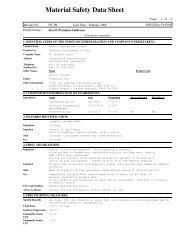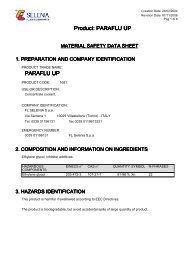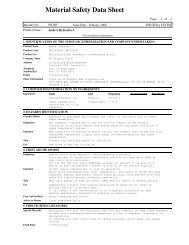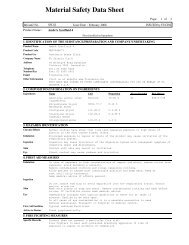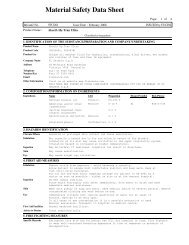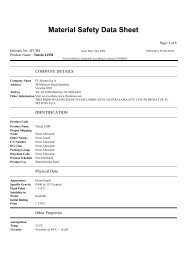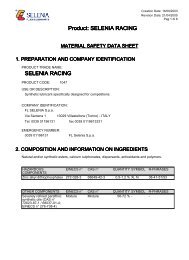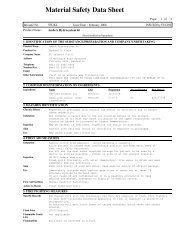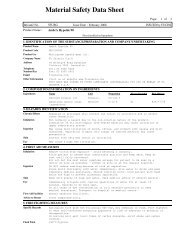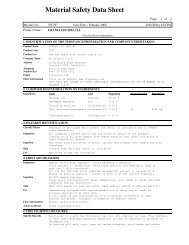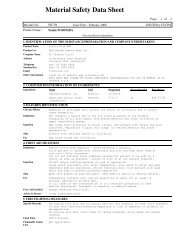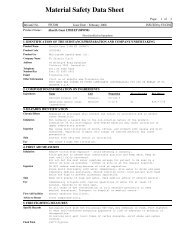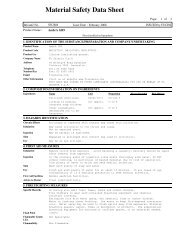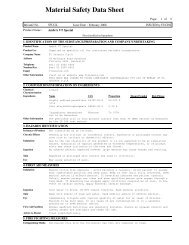Paraflu F.E. - FL Selenia
Paraflu F.E. - FL Selenia
Paraflu F.E. - FL Selenia
Create successful ePaper yourself
Turn your PDF publications into a flip-book with our unique Google optimized e-Paper software.
Material Safety Data Sheet<br />
Page: 1 of<br />
Infosafe No. 5FULL Issue Date : February 2008 ISSUED by FUCHS<br />
Product Name :<br />
<strong>Paraflu</strong> 11 F.E<br />
Classified as hazardous<br />
1. IDENTIFICATION OF THE SUBSTANCE/PREPARATION AND COMPANY/UNDERTAKING<br />
Product Name<br />
Product Use<br />
Company Name<br />
Address<br />
Telephone<br />
Number/Fax<br />
Email<br />
Other Information<br />
<strong>Paraflu</strong> 11 F.E<br />
Automotive radiator coolant - concentrate.<br />
<strong>FL</strong> <strong>Selenia</strong> S.p.A<br />
49 McIntyre Road Sunshine<br />
Victoria 3020 Australia<br />
Tel: 03 9300 6400<br />
Fax: 03 9300 6401<br />
flselenia.com<br />
Visit us at website www.flselenia.com.<br />
THIS MSDS WAS ISSUED BY FUCHS ON BEHALF OF <strong>FL</strong> SELENIA S.p.A<br />
2. COMPOSITION/INFORMATION ON INGREDIENTS<br />
Ingredients<br />
Name CAS Proportion Hazard Symbol Risk Phrase<br />
Ethyleneglycol<br />
107-21-1<br />
30-60 %<br />
Sodium Benzoate 532-32-1 1-3 % Xi R36<br />
Sodium nitrite 7632-00-0 0-0.2 % T, O R25, R8<br />
Water<br />
3. HAZARDS IDENTIFICATION<br />
Route(s) of Entry<br />
Chronic Effects<br />
Inhalation<br />
Ingestion<br />
Skin<br />
Eye<br />
4. FIRST AID MEASURES<br />
Inhalation<br />
Ingestion<br />
Skin<br />
Eye<br />
First Aid Facilities<br />
Advice to Doctor<br />
Harmful if swallowed.<br />
5. FIRE FIGHTING MEASURES<br />
7732-18-5<br />
Inhalation, skin and ingestion.<br />
To 100%<br />
For ethylene glycol:<br />
No effects on fertility were found in a long term animal study dosed orally.<br />
Repeated ingestion may cause kidney damage.<br />
Inhalation of vapour or mists generated by heating, stirring or spraying<br />
can result in headaches and irritation of the throat and nose.<br />
Ethylene glycol is toxic when swallowed. A lethal dose for an adult is 1-2 ml per<br />
kg, or about 100 ml. Symptoms include staggering, slurred speech, loss of coordination,<br />
confusion, faintness, nausea, vomiting, increased heart rate,<br />
difficulty breathing, difficulty seeing, convulsions and collapse. Symptoms may be<br />
delayed. Decreased urine output, kidney failure and nervoussystem damage may also<br />
occur. Aspiration may occur during swallowing or vomiting, resulting in lung<br />
damage.<br />
Will have a degreasing action on the skin. Contact with skin may result in<br />
irritation.<br />
Repeated or prolonged skin contact may lead to dermatitic effects.<br />
May be an eye irritant.<br />
Remove victim from exposure - avoid becoming a casualty.<br />
Remove contaminated clothing and loosen remaining clothing.<br />
Allow patient to assume most comfortable position and keep warm. Keep at<br />
rest until fully recovered.<br />
Seek medical advice if effects persist.<br />
Rinse mouth thoroughly with water immediately. Give plenty of water to drink but<br />
do not induce vomiting. Seek immediate medical assistance. Do not give anything by<br />
mouth to an unconscious or convulsing person.<br />
Wash with plenty of soap and water. Remove contaminated clothing and wash before<br />
re-use. If irritation occurs seek medical advice.<br />
Immediately irrigate with copious quantity of water for at least 15 minutes.<br />
Eyelids to be held open.<br />
Seek immediate medical assistance.<br />
Typical washroom facilities.<br />
Treat symptomatically and as for exposure to ethylene glycol.<br />
4
Material Safety Data Sheet<br />
Page: 2 of<br />
Infosafe No. 5FULL Issue Date : February 2008 ISSUED by FUCHS<br />
Product Name :<br />
Specific Hazards<br />
Hazardous<br />
Combustion Products<br />
Flash Point<br />
<strong>Paraflu</strong> 11 F.E<br />
Classified as hazardous<br />
Combustible liquid. Will burn if involved in a fire but not considered to be<br />
a significant fire risk.<br />
Fire fighters to wear self-contained breathing apparatus if risk of<br />
exposure to vapour or products of combustion.<br />
EXTINGUISHING MEDIA: Water jets, water fog, foam, dry agent (carbon<br />
dioxide, dry chemical powder). Avoid high pressure water jet.<br />
Combustion products include oxides of carbon.<br />
Compoounds of nitrogen and products of incomplete combustion.<br />
Not applicable due to water content<br />
Ignition Temperature 490°C (50% dilution)<br />
Flammable Limits<br />
LEL<br />
Explosion Data<br />
Not available<br />
Not available<br />
6. ACCIDENTAL RELEASE MEASURES<br />
Spills & Disposal<br />
7. HANDLING AND STORAGE<br />
Storage<br />
Slippery when spilt. Avoid accidents, clean up immediately. In event of large<br />
spill: Use absorbent (soil or sand, sawdust, inert material, vermiculite). Sweep<br />
up. Collect and seal in properly labelled drums for disposal. Wash area down with<br />
detergent and excess water. Contain - prevent contamination of drains and<br />
waterways.<br />
Wear protective equipment to prevent skin and eye contamination and<br />
inhalation of vapours.<br />
Refer to State Land Waste Management Authority for disposal.<br />
(Victoria:MMBW (03) 9615 6099)<br />
Classified as a C1 (COMBUSTIBLE LIQUID)<br />
8. EXPOSURE CONTROLS/PERSONAL PROTECTION<br />
National Exposure<br />
Standards<br />
Personal Protective<br />
Equipment<br />
Eng. Controls<br />
No value assigned for this specific material by the National Occupational<br />
Health and Safety Commission (Worksafe Australia).<br />
However, Exposure Standards for Ethylene glycol (vapour):<br />
(As published by the National Occupational Health and Safety Commission)<br />
TWA - 60 (mg/m3) STEL - 120 (mg/m3)<br />
Overalls or similar protective apparel. Safety glasses,goggles or faceshield as<br />
appropriate. Rubber gloves. Always work in a well ventilated area.<br />
Avoid skin and eye contact and inhalation of vapour and mist.<br />
Wear overalls, safety shoes, chemical goggles and impervious gloves.<br />
Use with adequate ventilation. If inhalation risk exists wear organic<br />
vapour/particulate respirator meeting the requirements of AS/NZS 1715 and<br />
AS/NZS 1716.<br />
Always wash hands before eating, smoking, drinking or using the toilet.<br />
Wash contaminated clothing and other protective equipment before storing<br />
or re-using.<br />
Must be sufficient to prevent breathing of vapour. Maintain concentration below<br />
recommended exposure limit.<br />
Vapour at elevated temperatures heavier than air - prevent concentration in<br />
hollows or sumps.<br />
DO NOT enter confined spaces where vapour may have collected.<br />
Keep containers closed when not in use.<br />
9. PHYSICAL AND CHEMICAL PROPERTIES<br />
Appearance<br />
Boiling Point<br />
Solubility in Water<br />
Specific Gravity<br />
(H2O=1)<br />
pH Value<br />
Vapour Pressure<br />
Vapour Density<br />
(Air=1)<br />
Green blue liquid.<br />
108°C (50% dilution)<br />
Completely soluble.<br />
1.084 @ 20°C typical<br />
7.7 (50% aq. soln by volume)<br />
Not available<br />
Not available<br />
4
Material Safety Data Sheet<br />
Page: 3 of<br />
Infosafe No. 5FULL Issue Date : February 2008 ISSUED by FUCHS<br />
Product Name :<br />
Physical State<br />
Volatile Component<br />
Flash Point<br />
<strong>Paraflu</strong> 11 F.E<br />
Liquid.<br />
Not available<br />
Classified as hazardous<br />
Not applicable due to water content<br />
Ignition Temperature 490°C (50% dilution)<br />
Flammable Limits<br />
LEL<br />
Explosion Properties<br />
Other Information<br />
Not available<br />
Not available<br />
Soluble in water and alcohol.<br />
10. STABILITY AND REACTIVITY<br />
Hazardous<br />
Polymerization<br />
Materials to Avoid<br />
Hazardous Reaction<br />
Will not occur.<br />
Strong oxidisers, hard acids and bases.<br />
Reacts with acids and oxidising agents.<br />
11. TOXICOLOGICAL INFORMATION<br />
Toxicology<br />
Information<br />
Inhalation<br />
Ingestion<br />
Skin<br />
Eye<br />
Chronic Effects<br />
12. ECOLOGICAL INFORMATION<br />
Environ. Protection<br />
13. DISPOSAL CONSIDERATIONS<br />
No LD50 data available for product.<br />
However, for ethylene glycol (major constituent):<br />
Oral LD50 (rat) : 4700 mg/kg<br />
Oral Lowest Lethal Dose (human); 786 mg/kg<br />
Oral Lowest Lethal Dose (human): 398 mg/kg - headache, nausea, vomiting.<br />
Dermal LD50 (rabbit): 9530 mg/kg<br />
Inhalation Lowest Toxic Concentration (human): 10,000 mg/m3 - lachrymation,<br />
cough.<br />
Estimated Lethal Dose (human): 100 ml<br />
SKIN (rabbit): Mild irritant.<br />
EYES (rabbit): Mild irritant.<br />
The brain, lungs, liver and kidneys are the main organs affected by the<br />
systemic intoxication and renal failure is the usual cause of death.<br />
Treatment is as for oxalate poisoning, as ethylene glycol is metabolised<br />
to oxalic acid which is deposited in various organs as calcium oxalate<br />
crystals.<br />
Animal studies have shown that long term repeated exposure to high doses of<br />
ethylene glycol in the diet causes kidney injury.<br />
Not mutagenic in several IN VITRO mutagenicity studies.<br />
Birth defects were observed when ethylene glycol was administered to<br />
pregnant mice or rats in high doses in the diet or as a respirable aerosol.<br />
No effects were noted in the reproductive systems of male or female mice or<br />
rats nor on their reproductive performance.<br />
Several long term animal tests have found no carcinogenic effects.<br />
Inhalation of vapour or mists generated by heating, stirring or spraying<br />
can result in headaches and irritation of the throat and nose.<br />
Ethylene glycol is toxic when swallowed. A lethal dose for an adult is 1-2 ml per<br />
kg, or about 100 ml. Symptoms include staggering, slurred speech, loss of coordination,<br />
confusion, faintness, nausea, vomiting, increased heart rate,<br />
difficulty breathing, difficulty seeing, convulsions and collapse. Symptoms may be<br />
delayed. Decreased urine output, kidney failure and nervoussystem damage may also<br />
occur. Aspiration may occur during swallowing or vomiting, resulting in lung<br />
damage.<br />
Will have a degreasing action on the skin. Contact with skin may result in<br />
irritation.<br />
Repeated or prolonged skin contact may lead to dermatitic effects.<br />
May be an eye irritant.<br />
For ethylene glycol:<br />
No effects on fertility were found in a long term animal study dosed orally.<br />
Repeated ingestion may cause kidney damage.<br />
For ethylene glycol: Aquatic toxicity - LD50/24hr (goldfish): >5000mg/L.<br />
4
Material Safety Data Sheet<br />
Page: 4 of<br />
Infosafe No. 5FULL Issue Date : February 2008 ISSUED by FUCHS<br />
Product Name :<br />
<strong>Paraflu</strong> 11 F.E<br />
14. TRANSPORT INFORMATION<br />
Storage and<br />
Transport<br />
15. REGULATORY INFORMATION<br />
Risk Phrase<br />
Safety Phrase<br />
Hazard Category<br />
16. OTHER INFORMATION<br />
Classified as hazardous<br />
Store in a cool place and out of direct sunlight.<br />
Classified as a C1 COMBUSTIBLE LIQUID for the purpose of storage and<br />
handling, in accordance with the requirements of AS1940.<br />
Not defined as a Dangerous Good by the Australian Code for the Transport of<br />
Dangerous Goods by Road and Rail.<br />
This material is a Scheduled Poison (S5) and must be stored, maintained and<br />
used in accordance with the relevant regulations.<br />
Store away from oxidizing agents, acids and foodstuffs.<br />
R22 Harmful if swallowed.<br />
S13 Keep away from food, drink and animal feeding stuffs.<br />
S2 Keep out of reach of children.<br />
S24/25 Avoid contact with skin and eyes.<br />
S46 If swallowed, seek medical advice immediately and show this container or<br />
label.<br />
Harmful<br />
Contact Person/Point Laboratory Manager (03) 9300 6400<br />
Research & Development Chemist (03) 9300 6400<br />
This information was prepared in good faith from the best information available at<br />
the time of issue. It is based on the present level of research and to this extent<br />
we believe it is accurate. However, no guarantee of accuracy is made or implied<br />
and since conditions of use are beyond our control, all information relevant to<br />
usage is offered without warranty. The manufacturer will not be held responsible<br />
for any unauthorosed use of this information or for any modified or altered<br />
versions.<br />
4<br />
If you are an employer it is your duty to tell your employees, and any others that<br />
may be affected, of any hazards described in this sheet and of any precautions<br />
that should be taken.<br />
References<br />
Material Safety Data Sheets are updated frequently. Please ensure you have a<br />
* NOHSC:2011 National Code of Practice for the Preparation of Material Safety Data<br />
Sheets<br />
* NOHSC:1008 Approved Criteria for Classifying Hazardous Substances<br />
* NOHSC:10005 List of Designated Hazardous Substances<br />
* NOHSC:1005 Control of Workplace Hazardous Substances, National Model Regulations<br />
* NOHSC:2007 Control of Workplace Hazardous Substances, National Code of Practice<br />
* NOHSC:1003 Exposure Standards for Atmospheric Contaminants in the Occupational<br />
Environment, National Exposure Standards<br />
* NOHSC:3008 Exposure Standards for Atmospheric Contaminants in the Occupational<br />
Environment, Guidance Note<br />
* NOHSC:1015 Storage and Handling of Workplace Dangerous Goods, National Standard<br />
* NOHSC:2017 Storage and Handling of Workplace Dangerous Goods, National Code of<br />
Practice<br />
* SUSDP, Standard for the Uniform Scheduling of Drugs and Poisons<br />
* ADG, Australian Dangerous Goods Code<br />
* MSDS of component materials<br />
Last Change<br />
Hazard Category<br />
Supercedes Issue Date: Not applicable<br />
Reason(s) for issue: Alignment to Worksafe requirement<br />
Safety data sheets are updated frequently. Please ensure that you have a<br />
current copy.<br />
Harmful<br />
...End Of MSDS...



